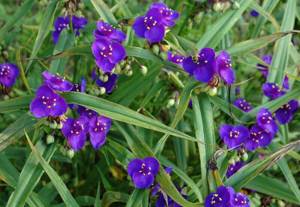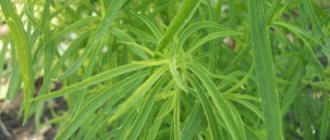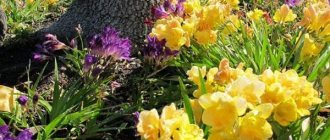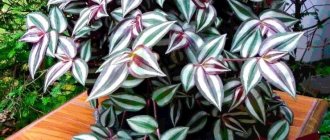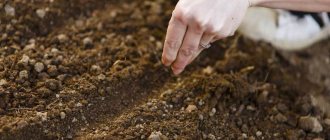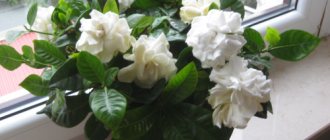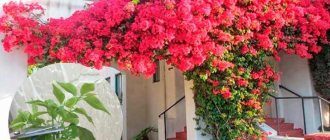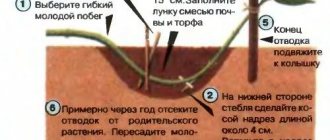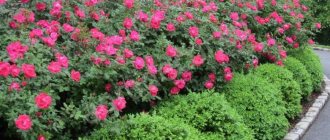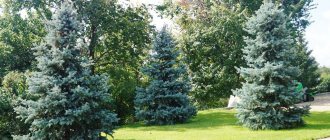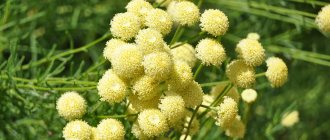A beautiful perennial plant - garden tradescantia - decorates the landscape designs of many gardeners or simply lovers of beautiful flowers. This plant has gained popularity due to the variety of varieties that make it possible to create multi-colored combinations of unusual beauty that delight the human eye and attract attention. Tradescantia bush helps to create flower thickets that are pleasing to the eye. It combines especially beautifully with irises and daylilies. Tall varieties are planted near small rivers and lakes.
Main characteristics of Tradescantia garden
Garden tradescantia is a perennial whose succulent shoots can reach a length of up to 1 meter. The leaves of the plant grow up to 20 cm and are located on numerous branches, forming dense bushes. Tradescantia leaves are characterized by the presence of small veins. They also come in a variety of colors. The foliage is greenish, purple, lilac, and variegated. The shoots are often intertwined, which is why they are called “women's gossip.” Garden tradescantia flowers have a varied color palette. They come in rich purple, blue, bright white, and pinkish. Each flower opens and delights with its beauty for only one day. But as soon as the inflorescence dries up and falls off, fresh buds immediately appear and bloom in its place. In general, Tradescantia blooms for 3-4 months.
Biological description of Tradescantia
| Family | Commelinaceae |
| Name | From lat. Tradescantia |
| Motherland | Tropical and temperate zones of America from northern Argentina to southern Canada |
| Plant type | Perennial evergreen herbaceous plants |
| Illumination | Shade-tolerant, prefers bright, diffused light |
| The soil | Loose, drained, nutritious |
| Watering | Moisture-loving, needs plenty of watering |
| Temperature | Heat-loving |
| Bloom | From spring to autumn, depending on the species |
| Height | Long creeping shoots, 20–100 cm |
| Reproduction | Vegetative (cuttings or dividing the bush |
_____________________________
By the way, constant flowering throughout almost the entire summer is one of the advantages of garden Tradescantia. _____________________________
Photo: Tradescantia blooms throughout the summer
Types and varieties of Garden Tradescantia
Breeders know more than 50 varieties of Tradescantia, but in the climatic conditions of central Russia, about 10 can be grown in flower beds in open ground.
The following types are especially popular:
- Tradescantia Anderson. A hybrid large-flowered variety bred by a botanist named Anderson from America (hence the name). The plant has straight purple leaves with a greenish tint. It grows up to 80 cm. The flowers are large in size and come in a variety of colors. They are white, purple, blue, pinkish. The Anderson variety is unpretentious. The basic rule of care is to ensure regular watering and fertilizing. If you properly care for the plant, it will delight you with its color from the beginning of summer until mid-autumn;

- rosy bride. The leaves of this plant variety have a glossy bronze surface, and the flowers have a soft pink pearlescent color. This is an unpretentious variety that does not require special care. The plant is not very tall, grows up to 40 cm in height. It pleases the eye with its flowers all summer long;
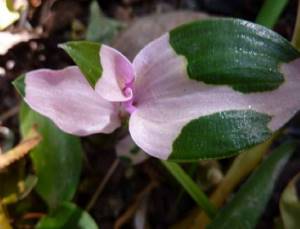
- Tradescantia virginiana (street). A variety especially loved by summer residents. It is distinguished by a dense bush, which is constantly covered with buds and flowers. Virginia Tradescantia has strong immunity to diseases. The process of planting and care does not involve anything special; everything is carried out according to standard rules. This variety is definitely worth choosing for those who want to decorate their garden with dense, constantly flowering bushes;
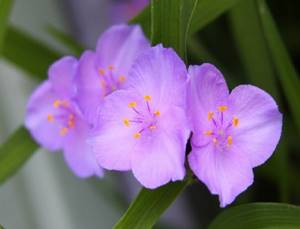
- wuegelin. The bright and beautiful blue inflorescences of this variety attract many lovers of contemplating natural splendor. In addition to its beauty, the plant is famous for its frost resistance and unpretentiousness to growing conditions, which makes it even more popular. Wegelin grows up to 0.5 meters in height and forms dense bushes. It blooms from the very beginning of summer until late autumn. Not afraid of many diseases and insect pests. But it is very important to monitor the watering of the plant, to which it is very demanding;
- charm mixture. Flower lovers appreciate this variety for its unpretentiousness. It is distinguished by a three-petaled monochromatic inflorescence, which can be white, blue, pink, blue. The plant is frost-resistant, not afraid of pests;
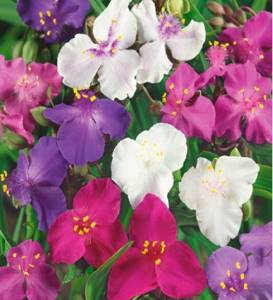
- Tradescantia striped. The length of the shoots of this variety is a maximum of 80 cm. Leaves up to 10 cm long are arranged alternately on the stem. The inflorescences have 3 petals and can be purple, pink, or violet.
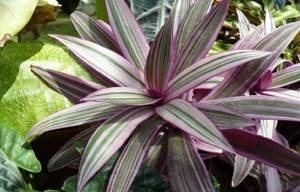
For a flower garden, it is better to choose several varieties of Tradescantia at once. Then a multi-colored lush rainbow will appear on the site, which will decorate any photo.
Tradescantia: reproduction
The plant propagates very well from cuttings. All methods give almost 100% survival rate. For garden crops, the best time for propagation is spring. It is recommended to propagate indoor flowers in spring, summer and early autumn. In winter it is better not to touch them.
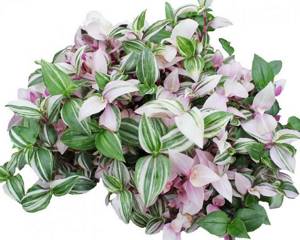
Evergreen plant of the tropical zone
Important! The stems of the plant are very fragile
Be careful when landing
How does it reproduce
The plant can be propagated in four ways. This:
- Growing Tradescantia from cuttings is an asexual type of propagation. With this method, cuttings are rooted in water and then transplanted into the ground;
- rooting of cuttings. In the internodes of the lashes there are rudiments of roots. When they touch the ground they quickly germinate. They can be cut from the mother bush and planted;
- dividing the bush. It is carried out during spring transplantation. The root is divided into parts and placed in separate containers;
- sowing seeds. The bush reproduces from seeds for a long time (2-3 years).
Growing from cuttings
The easiest way to get a new plant is by cuttings. Growing Tradescantia from cuttings involves cutting 12-15 cm pieces of healthy shoots and rooting.
Important! Cuts should be made under the nodes. Next, the planting material is placed in a container with water
It is recommended to disinfect water with an activated carbon tablet.
Next, the planting material is placed in a container of water. It is recommended to disinfect water with an activated carbon tablet.
After 1.5-2 weeks, roots appear. The seedlings are ready for transplanting into individual pots. To make the bush larger, you can select several seedlings for one pot, since it is not enough to propagate Tradescantia; you need to decorate the bush beautifully.
An important condition for the successful development of an indoor flower is soil fertility.
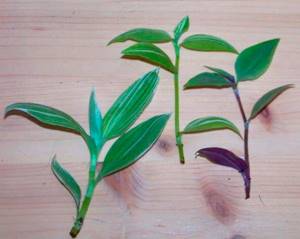
Cuttings must be carried out carefully
Often, gardeners bypass the stage of water rooting and plant fresh cuttings immediately in containers with soil. If the temperature and humidity conditions are observed, this method is quite justified.
In both cases, after 1.5-2.5 months it is possible to get a mature bush.
Choosing a location and planting tradescantia garden
In order for the plant to grow and develop correctly, be healthy and delight with its lush flowers, you need to take care of preparing the soil and choosing a planting site.
The ideal location for the perennial is a location with sandy soil or soil that drains very well. It should be located where the sun's rays do not fall constantly, but at a certain time of day, or where the Tradescantia will be protected from the rays by thickets of bushes and trees. They will also play a useful role in protecting the plant from strong gusts of wind and retain moisture in the soil. But the thickets should not be very dense, otherwise the bushes may not bloom in constant shade. The plant should not be planted in very dark places also because if there is a lack of sunlight, it will begin to reach for it and lose its dense bushiness.
Among Tradescantia, only variegated varieties like to grow in the open sun. In shady places they become faded and dull, and lose the brightness of their foliage. The best temperature regime for plants is 13-24 °C.
If the only place to plant garden Tradescantia is soil that quickly loses water, then you should take care of moisture-retaining fertilizers in advance. Mostly compost or clay is used. Humus and humus are added to the soil in advance. After planting Tradescantia, the soil is moistened abundantly and mulched with humus or peat. Such a caring attitude towards the plant will soon yield results: it will delight you with the bush’s lush growth and lush flowering.
Planting and caring for Tradescantia
The place for growing Tradescantia must be selected extremely carefully: it should be either sunny or semi-shaded (it is better to give preference to an area with a lot of shade or near a pond). The soil for planting is suitable only if it is moist and nutritious (sandstone is best).
In order for the plant to grow strong and healthy, it is enough to follow simple rules for caring for Tradescantia:
- Watering should be regular and generous, especially if the plant is located in the sun, since lack of moisture and excessive heat can cause the plant to stop growing, stop flowering, or even die.
- Feeding should not be frequent, but it is better if it is present. For the first time, it is advisable to apply mineral fertilizer at the moment the first strong shoots appear; in the second - at the moment of bud formation. This will be enough for the plant to fully develop and delight you with luxurious and long flowering. If the plant was planted in nutrient soil containing a large amount of clay, there will be no need for fertilizing in the next couple of years.
- Pests do not like Tradescantia, and it is not at all afraid of diseases, so no additional measures are needed to protect the young plant at the time of planting.
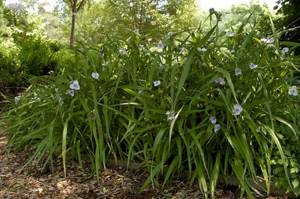
Tradescantia needs shelter for the winter
- Wintering is an important stage of plant care. Despite its unpretentiousness and resistance to cold, Tradescantia needs shelter during the cold season. So, before the onset of the first frost, it is better to cover the plant with fallen leaves - this will help protect it from freezing.
- Tying will be required only in cases where the flowering is too thick and lush and simply bends the plant to the ground. You can avoid this kind of trouble by tying the bush to a wooden support.
Advice. After the end of the flowering period of the plant, it is advisable to remove the flower stalks from it, since otherwise seedlings may spill out of them into the soil, which over time will sprout in the soil and will certainly spoil the appearance of the bush, since they will randomly thicken it.
Neighborhood with other flowers
Tradescantia very quickly loses its bush shape, especially after watering. Therefore, the plants are planted quite densely to avoid tying each one up. But this rule, unfortunately, does not work for tall plants. This feature should be taken into account when choosing the type of tradescantia. To prevent the perennial from being pulled out, experienced summer residents recommend planting a swimsuit or hosta next to it. Low-growing varieties are planted in close proximity to geraniums and lungworts. Such a neighborhood brings double benefits: geranium or lungwort support tradescantia and create beautiful harmonious compositions in the areas.
Rules for growing tradescantia
Presence of flowering. You should not expect lush flowering from the Tradescantia plant; it belongs to the representatives of decorative deciduous plants.
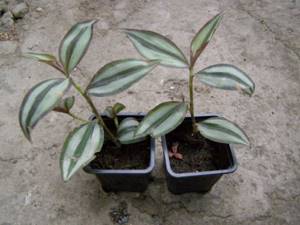
Photophilousness. The flowerpot is unpretentious to light. It can grow in both dark and well-lit places. However, direct sunlight is harmful. The best conditions are diffused light.
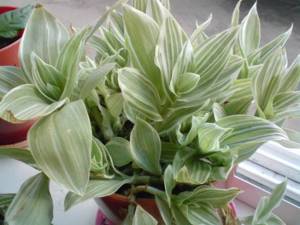
Temperature. Comfortable air temperature in the warm season is up to 25 degrees, in the cold season – no higher than 12.
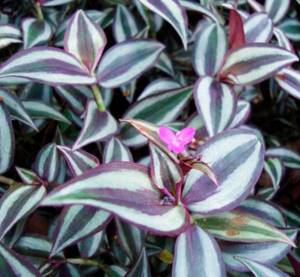
Watering. More moisture is required in summer; in winter, watering is necessary when the soil substrate in the flower pot is completely dry.
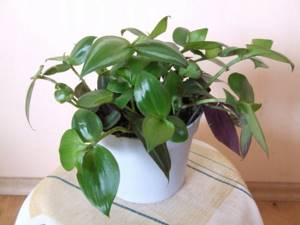
Moisture content. Good growth is achieved at normal humidity.
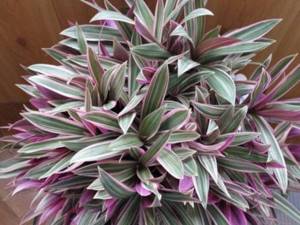
Feeding. You need to fertilize the flower every fifteen days in spring and summer, alternately using organic and mineral fertilizers.
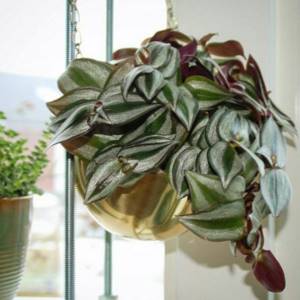
Time for a sanitary haircut. In the spring.
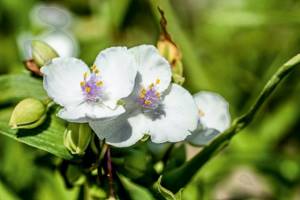
Transfer. The plant is replanted in the spring. Young bushes are replanted annually, mature ones - once every 2-3 years.
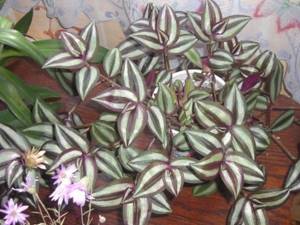
The soil. Ready-made mixtures for indoor plants, special soils for Tradescantia, self-prepared substrates (for four volumes of deciduous soil, two volumes of turf and humus and one volume of sand).
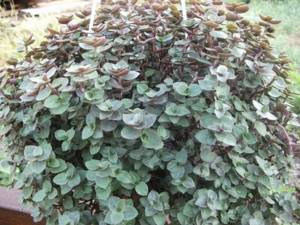
Pests. Thrips, scale insects and spider mites.
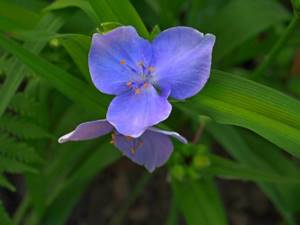
Diseases. Most often they appear due to improper care. They manifest themselves as bare shoots, rot, fading and spotting of leaf plates.
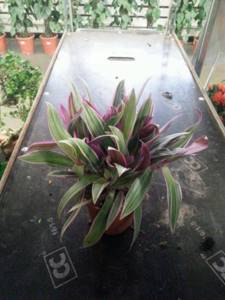
Poisonous properties. Sometimes when working with a plant, skin dermatitis appears on the hands. To avoid this, wash your hands well after contact.
Care
After the plant is planted, it must be constantly looked after. Although Tradescantia is quite unpretentious, it must still be cared for without fail. The plant feels comfortable in one place for several years. But the soil for this must be well prepared in advance (manure, humus, and compost are added to it).
Watering and loosening
Tradescantia garden is a moisture-loving plant, so the main condition for care is regular watering. The plant can withstand without water for quite a long time, but this will certainly affect the color of the leaves and the setting of buds. During cold weather, the frequency of watering decreases. If it is not possible to constantly water Tradescantia, you need to install an artificial irrigation system. As it gets colder, the number of waterings is reduced: they are carried out only when necessary, when the soil begins to dry out.
Tradescantia also needs to spray its leaves, which is carried out in the morning or evening, but always when there is no sun. If you spray a plant during solar activity, the droplets of water remaining on the leaves can act like a magnifying glass. A ray of sunlight hitting it will burn the leaf.
In addition to moistening the soil, you need to ensure that a dry, dense crust does not form on it. To do this, regular loosening is carried out. This way, the optimal amount of oxygen is supplied to the roots of the plant, and normal drainage is ensured (moisture does not stagnate).
Top dressing
Comprehensive care for garden tradescantia includes regular feeding. The first is carried out in the spring, having previously cleared the soil of weeds. Top dressing should consist of mineral fertilizers. The plant is fed again at the very end of the spring period, in the last days of May. At this time, nitrogen fertilizers are used. Subsequent care includes the introduction of any complex fertilizers. The procedure is carried out after loosening the soil every 3 weeks. The appearance of the first buds is a signal to add phosphate and potassium fertilizers.
Pruning and wintering
Although garden tradescantia is practically indifferent to frost, if the region where the plant is planted regularly experiences winters without snow, with gusty, cold winds, it is recommended to cover it with a thick layer of fallen leaves before the first frost. This will help him survive the winter well, especially in the first year after planting a young Tradescantia. If strong winds and cold weather are expected, you can trim the plant completely and mulch the soil with peat, humus, and moss to prevent the roots from freezing. Cover the perennial only if a severe, snowless, windy winter is expected.
Trimming or pinching the aboveground part of Tradescantia is carried out a couple of times a year. This helps preserve the decorative appearance of the bush. It can be transplanted to another place no more than once every 3-4 years.
Bloom
Only home and garden varieties of Tradescantia bloom. And they delight with their colorful buds, starting from late spring and ending in late autumn. But it all depends on the plant variety. If you want to observe lush multi-colored clusters on your plot for 4-5 months, then you need to plant different varieties of Tradescantia. Each flower lives only for a day, after which it dries up. Withered flowers and buds must be removed in a timely manner - this significantly increases the flowering period of the bush.
Tradescantia propagation
Most often, perennials are bred using vegetation. A cutting is cut from the bush and placed in a jar of water. Some gardeners immediately plant cuttings in warm, moist soil. Usually, cuttings with 2-3 foliage growth points (nodes) are taken from plants that have lived for 2 seasons. Planted in river sand, deepening 1 node. Tradescantia takes root quite well, the very next day roots appear on the cuttings, and after 20 days the root system will develop, and soon the garden will be decorated with lush, dense bushes.
It is possible to propagate garden tradescantia by dividing the bush. Carefully, trying not to damage the root system, divide the bush in half and plant each part in moist soil.
Cultivation of garden tradescantia is also practiced by seed method. In late autumn, seeds are planted in warm, moist soil. It is better if it is a substrate of turf and leaf soil, which is regularly irrigated with water. After 2 months, seedlings should appear. In the spring, seedlings are picked. As soon as a bush with 4 leaves is formed, and the soil in the garden is warm enough, the plant is transplanted there. Propagation by seeds is not very often practiced due to the low germination rate of seedlings.
Reproduction and planting of perennial street tradescantia
Tradescantia is easy to propagate. You can grow a flower using cuttings, dividing the bush and seeds.
Cuttings
Cuttings for propagation should be prepared in spring or summer so that they have time to adapt and strengthen before winter frosts. Propagate a flower step by step:
- cuttings are cut from the tops of the stems; each specimen should have several internodes;
- the lower leaves are removed;
- planting material is placed for several days in a container with water or moist sandy soil;
- rooted cuttings are planted in a container for growing or in a shaded area;
- It is better to prepare the soil for young flowers in advance by mixing leaf and turf soil with a small amount of sand.
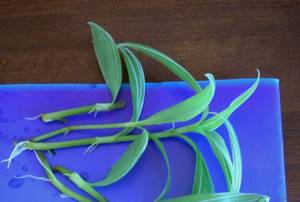
The cuttings are watered regularly, but moderately. The comfortable temperature for young sprouts is 22-24˚C.
Dividing the bush
The method most often used for propagation is dividing the bush. To carry out this manipulation, you should remove the root part from the soil and divide it into several parts. You don’t have to completely dig the rhizome out of the ground, but simply separate a few roots with a shovel.
The separated parts are planted in a prepared place. Delenki are distinguished by their ability to easily and painlessly take root in a new area. A flower grown in this way will delight you with flowering already in the year of planting.
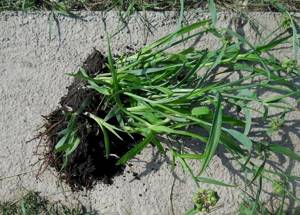
For the mother plant, such manipulations will only be beneficial - it will rejuvenate and develop more actively.
Seeds
When propagated by seed, plants do not retain varietal characteristics. This method is used in breeding work when they want to develop a new variety. You can also grow flowers from seeds at home. The landing procedure is carried out as follows:
- seeds are sown in winter so that sprouts sprout with the arrival of spring;
- the soil in the container should be light. The bottom of the container must be filled with a layer of drainage;
- seeds are planted up to 2 cm deep;
- the container is covered with film to create greenhouse conditions;
- the planted seeds are transferred to a room with a temperature of about 24˚C;
- It is better not to water the seedlings, but to regularly spray them with a spray bottle with warm water.
After 2-3 full leaves appear, you can transplant the sprouts into open soil. A plant grown by seed blooms after three years.
Planting procedure
The flower is planted by seeds, rooted cuttings or divisions. Planting should be done in early spring, and when propagated by root division, in the fall. Before the procedure, you need to prepare the soil: remove weeds, dig up and feed with organic fertilizers, you can use humus, peat or vermicompost.
Planting is carried out as follows:
- make small holes;
- place the plant in them, holding it in an upright position;
- at the bottom of the hole, carefully straighten the roots;
- gradually fill the hole with soil, followed by compaction;
- the flower must be in the ground right up to the root collar so that it deepens 2-3 cm;
- After planting, tradescantia should be watered and the soil around the roots should be mulched with humus.
If before planting the flower lived in a greenhouse or in an apartment, it needs to be created with similar conditions for the first time.
The planted crop is covered for several days with special material that will help protect it from wind, night coolness or scorching rays. After 2-3 days, the flower will adapt to the environment, and the cover can be removed.
Use in landscape design
The ornamental plant has long gained popularity in landscape design. It is used to decorate banks near bodies of water, decorate flower beds, create decorative compositions, etc. Outdoor Tradescantia goes well with other flowers and plants. When planting, you should take into account the height and density of the planting so that the planted crops do not interfere with each other, but create a harmonious flower garden.
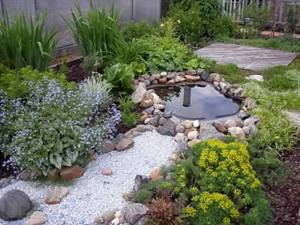
It goes well with daylilies, ferns, hostas, and heucheras.
When planting a flower, it is important to take into account its characteristics. Place the culture in slightly shaded mixborders, at the bottom of an alpine hill, near fences or in the shade of a house. You need to choose the location very carefully, because the color of the foliage and the duration of flowering depend on it. When planting tall varieties on a plot, you should remember about the garter. You can choose strong “neighbors”, because well-chosen plants will become an excellent support and will look great in the flowerbed.
It will also be interesting: Chrysanthemum multiflora (spherical) - planting and care, wintering in open ground?
Pest control and disease prevention
Garden Tradescantia is not afraid of pests. However, against the background of high humidity, nematodes or slugs may appear on it. If this has already happened, then you need to cut off the entire above-ground part of the plant and burn it. To prevent diseases and pests, you should plant watercress or mustard next to Tradescantia.
In dry summers, the plant is sometimes attacked by bugs that eat the stamens of the buds. They must be collected by hand, and for prevention, the Tradescantia bush must be irrigated with wormwood or tansy infusion.
The plant gets sick due to lack or excess of moisture and sunlight. You should pay attention to its condition. If the tips of the leaves turn brownish, you need to moisten them by spraying them with a spray bottle. The appearance of elongated stems with small foliage indicates a lack of sun. It is important to ensure that Tradescantia gets enough sunlight.
Garden perennial Tradescantia, planting and caring for which will not cause the gardener much trouble, looks excellent in landscape design, especially in recreation areas near small bodies of water. It attracts insects, whose fluttering and buzzing creates an atmosphere of relaxation and euphoria in addition to the beauty of the lush colorful flowers. In addition to beauty, Garden Tradescantia perfectly purifies the air from pathogenic bacteria, protects against electromagnetic radiation, and moisturizes well. Whatever plant variety is chosen, it will look spectacular in any landscape, delighting with thick, bright clusters of flowers.
Garden tradescantia in landscape design

Tradescantia feels comfortable not only indoors, but also outdoors. The beautifully flowering bush grows in one place for more than 10 years, so this plant has found wide application in landscape design. Thanks to the rich palette of colors, you can create the most beautiful elements on your site, especially when paired with garden daylilies, irises or ferns.
A wide variety of species allows you to combine garden tradescantia with other flowers in an unconventional way. Most often, its tall varieties are planted back, and geranium is planted forward. The ideal place for planting is various ponds located in gardens and gazebos. Despite the lack of smell, many butterflies arrive, attracted by the bright flowers. Bees and bumblebees are infrequent visitors to the plant.
To extend the flowering time of the bush, it is necessary to remove faded flowers. Then new colorful inflorescences will form in their place.
Gardeners note that purple and white Tradescantia look most impressive. But a vigorous plant often brings problems: it does not hold its shape well. When watering, the bush lies down, in which case the stems are tied up. If you choose the wrong planting location, the plant may not behave as desired. In strong shade it stretches out too much, so an alternative would be some shade or sun.
There was a popular belief that tradescantia protected the house from the evil eye and envy. Flowers destroy electromagnetic rays and purify the air. If you admire a plant for half an hour a day, you can feel how your soul has become lighter, peace has appeared.
Diseases and pests
Garden tradescantia is resistant to plant diseases and has high resistance to pests that are often found in the garden.
The appearance of infections and harmful insects is often caused by a violation of basic care.
| Type of lesion | Control measures |
| Nematode. After its appearance, the foliage becomes covered with light yellow specks. The leaves shrink and then die. When severely damaged, the shoots dry out. | The affected aerial part is cut off. The plant is treated with fungicidal preparations. Cruciferous plants planted around the perimeter of Tradescantia growth, such as mustard, watercress, and marigolds, help clear the soil of the pest. |
| Bronze beetles. The stamens are eaten away. | Insects are collected by hand. The plant is sprayed with infusions of tansy and wormwood. |
| Slow growth and lack of flowering. Occurs with rare watering or, conversely, flooding of roots, growing in the shade. | Normalize watering. The flower flooded with water is transplanted to a new place. |
| Dried leaves. Observed during prolonged exposure to direct sun. | The plant is shaded and provided with sufficient water. |
| Spotting and deformation of buds. The most common cause is a fungal disease. | The root system is analyzed for the presence of rotten fragments, the affected areas are cut off, the surviving roots and aerial parts are treated with fungicides. |
| Aphids, scale insects. The first signs are curling and falling leaves. | The leaf mass is washed with a soap solution (50 g per 1 liter of water) and sprayed with insecticides. |
Caring for perennials in open ground
Garden tradescantia does not require special care or any special knowledge. But if you want to preserve its beauty and attractiveness for a long time, then you need to pay attention to the plant. Particular care must be taken to monitor the condition of the soil and moisture levels.
The soil
In order for the plant to feel comfortable, it is necessary to plant Tradescantia in fertile, light and slightly acidic soil. Soft sandy or well-drained soil is ideal for this. If we look at the composition of the soil, it should include humus or turf. Soil with leaves or sand is also suitable.
Fertilizers and fertilizers
Since Tradescantia is a tropical plant, it needs to be fed consistently. For this purpose, organic and mineral fertilizers are used. It is important that they contain as little nitrogen as possible, because it negatively affects the appearance of the plant: it changes the color of the leaves and reduces flowering.
At each stage of development, different types of feeding are required. When the plant is actively growing, fertilizer should be applied twice a week when watering, prematurely clearing the area of weeds.
This first feeding is done in the spring, and in winter it is applied once every 45 days. The correct solution would be to use peat oxidate or any balanced special fertilizers. When Tradescantia blooms for the first time, it is necessary to fertilize it with potassium and phosphate. Over the next 10 days, use a low concentration fertilizer complex in the evening.
Landing
When choosing a landing site, you need to consider several factors. The site should not be located in an open area, because strong winds are detrimental to the plant. Also, soil from which moisture quickly drains is not suitable. But if there is no other possibility, then it is necessary to use moisture-retaining fertilizers: sawdust, compost or clay.
Tradescantia should not grow in constant shade, for this reason it will stretch out and not bloom. The ideal option would be a place slightly shaded by trees.
Before planting, apply organic fertilizers: humus or humus. Then the soil is prepared, weeds are removed and the soil is loosened. Next, small holes are dug or grooves are prepared. The plant is lowered into them, carefully straightening and distributing the root system. When falling asleep, it is important to position the Tradescantia so that the root collar is located 2-3 cm below ground level. After this, you need to water the planted plant abundantly and mulch.
Watering
Tradescantia loves abundant watering, as it is considered a marsh plant. Gardeners often note that it is insatiable for water, so you need to carefully monitor the moisture level in the soil. The flowering and external condition of Tradescantia depend on watering. In summer, the plant requires constant watering; the top layer of soil should not dry out. But even here you need to know when to stop: Tradescantia can die from too much water. It is necessary to periodically loosen the soil to prevent rotting of the root system.
In hot weather, watering alone is not enough; spraying with water in the evening is required to maintain air humidity. For this purpose, distilled or rain water is used. The presence of lime in the water will affect the color of the flowers - they will fade.
Transfer
Tradescantia can grow in the same place for quite a long time, however, it needs to be replanted periodically. When a plant begins to bloom poorly, it needs to be divided and rejuvenated. This is done once every five years in the spring, just at this time young shoots appear.
Care instructions
The ornamental crop is not demanding in care, but in order to maintain its visual appeal, certain conditions must be observed for optimal growth and flowering, especially this rule concerns the composition of the soil and moisture levels:
- in temperate and warm climatic conditions, garden tradescantia are able to winter in open ground without the use of shelter;
- in cold climates and regions with little snow and low temperatures, plants require covering with polyethylene;
- before using film cover, the root system of Tradescantia must be insulated with a layer of moss or any other insulation;
- after flowering, it is recommended to cut off the flower stalks, and mulch the soil around the bush with peat chips and insulate it with spruce branches;
How to plant tradescantia (video)
- in the summer, garden tradescantia, regardless of the variety, need sufficient, abundant watering, and the soil must be constantly moist;
- in late autumn, watering should be gradually reduced;
- insufficient irrigation measures often cause a slowdown in growth processes, lack of flowering and death of ornamental crops;
- For full growth and development, a garden plant needs moderate humidity, but on too hot days, the above-ground part is sprayed in the evening;
- in early spring, it is very important to carry out the first fertilizing of garden Tradescantia with complex fertilizers for flowering crops;
- the second feeding is carried out at the budding stage.
Regularly, you need to carefully inspect flower plantings and, if necessary, treat Tradescantia with insecto-fungicidal compounds.
